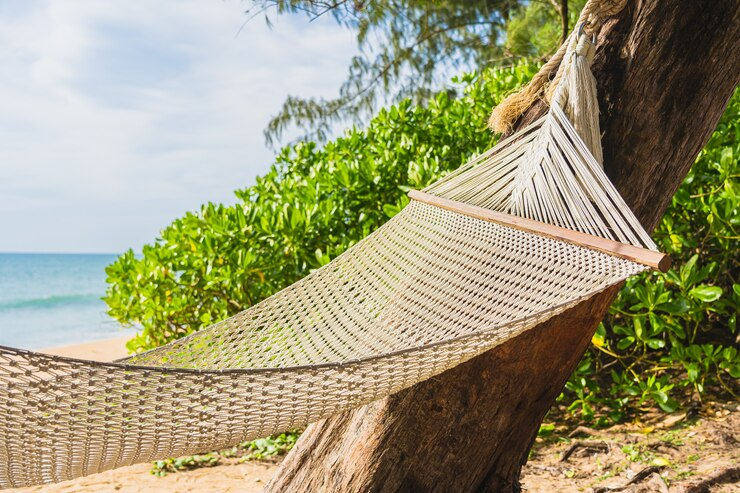
Imagine a gentle breeze swaying your hammock. A warm summer day beckons you to close your eyes, rhythmic creaks melting away. But what if a few trees limit your perfect spot? A DIY hammock stand – that’s your gateway to hammock bliss anywhere in your outdoor haven.
You can build your stand to customize your relaxation zone’s size, style, and location. One crucial decision, though, is to choose the suitable wood before grabbing the saw and hammer. Wrong wood leads to wobbly, short-lived eyesores.
But the perfect wood? It’s the foundation for countless afternoons swaying in pure contentment. This guide navigates the lumber world, ensuring your DIY hammock stand becomes sturdy, stylish, and the centerpiece of your outdoor sanctuary.
Key Considerations When Choosing Wood

1. Durability and Strength
Selecting wood for a hammock stand is like building a home’s strong base. It’s not just about holding weight temporarily; it’s about lasting through seasons for years. In 2024, durable, weather-resistant woods are trending.
Teak leads outdoor furniture trends, and people value its ability to resist warping, cracking, and brittleness. Its natural oils repel water and snow, keeping your hammock and making it stand as sturdy as when you built it.
Also, a study emphasizes wood durability against wood-destroying fungi in temperate climates as crucial. European standards EN 350 and EN 113-2 guide testing and classifying wood durability, ensuring your hammock stand resists these natural threats.
Your hammock stand needs immense strength to hold your weight (and maybe a napping buddy!). Consider your hammock’s weight capacity — some, like Key West Hammock Company’s wood hammock stand, boast a 500-pound capacity!
2. Exposure to Elements
When choosing wood for hammock stands, you should consider climate and exposure to elements of nature. Weather impacts a material’s durability and performance. In 2024, the outdoor furniture market will reach US$52.42 billion revenue.
A big part focuses on weather-resistant materials. For example:
· Full Sunlight: For sunny areas, teak and faux teak are top picks. Teak resists sun damage like warping or fading. Faux teak offers similar resilience while withstanding extreme conditions.
· Partial Shade: Cedar works well in partial shade. It resists rot naturally without chemical treatments – a safe, sustainable option.
· Covered Areas: Softer woods like pressure-treated pine suit covered areas. Treatment enhances moisture and insect resistance, extending wood life. Your hammock stand stays sturdy outdoors.
Proper wood selection ensures hammock stand durability and low maintenance. Following these, you’ll choose wood meeting aesthetic needs and withstanding environmental challenges.
3. Workability and Appearance

Working wood delivers satisfaction. Projects in 2024 highlight usability and looks, with materials that are easy to craft and yet appealing. Several characteristics of wood appeal to enthusiasts. For example:
Craftability matters: Popular woods are sturdy yet manageable. Pine and cedar suit beginners; soft textures simplify cutting and shaping. Oak and maple challenge experienced artisans; dense grains demand precision but yield durable, beautiful results.
Darker tones are also ideal for conveying luxurious depth in furniture designs. Rich hues, warm spaces elegantly – suitable for a DIY hammock stand with distinction. Or, embrace natural imperfections: knots, patterns – let each piece unveil its story.
Select woods that resonate with your style and narrative. Whether softwood’s simplicity or hardwood sophistication, guided by current standards, your hammock stand blends function and individuality.
4. Environmental Impact and Sustainability
Selecting, environmentally-conscious, suitable wood for DIY hammock, stands lets you relax in a sustainable creation while caring for your planet. Making mindful DIY choices contributes to a greener tomorrow in small yet meaningful ways.
Materials like bamboo, which is a grass, have become popular choices. Bamboo grows fast and can be harvested carefully. It’s sturdy and flexible, so it works great for hammock stands without damaging the ecosystem.
Where wood comes from also matters because of transport. Locally-grown lumber supports nearby businesses but also cuts emissions from long shipping routes, making it an eco-friendlier pick for DIY projects.
Top Wood Choices for Hammock Stands
Picking a suitable wood for your DIY hammock stand is key to lasting use and beauty. Here’s an in-depth look at a few prime choices:
1. Pressure-Treated Pine
Pressure-treated pine is a budget-friendly favorite for many DIY enthusiasts. It is available widely. It’s chemically treated against rot, decay, and bugs, making it durable outdoors.
Though the treatment lends it a greenish hue, finishing can still make it visually appealing for gardens or patios.
2. Cedar
Known for natural splendor and toughness, it is a premium pick. Its reddish heartwood boosts outdoor spaces.
Cedar’s lasting years with minimal upkeep owes to its rot- and pest-resistant oils, earning it a higher price than treated pine. Its woodsy scent is a pleasant bonus.
3. Redwood
This wood’s property extends resistance to decay, insect infestation, and fire. Its tannic heartwood explains this resilience, making redwood exceptional for outdoor furniture like hammock stands.
Though pricier and scarcer than alternatives, its durability and low needs often justify the quality investment, plus its deep hue is strikingly eye-catching outside.
Additional Wood Options (For the Enthusiast)

Hardwood lovers know there’s irresistible: crafting with mahogany and oak. These sturdy beauties offer strength and style – the perfect combo for a standout hammock stand. They also have more substance than regular woods, giving your outdoor hangout some serious staying power.
With mahogany, you get that rich, reddish-brown color and those straight grains that never go out of style. It’s tough and resistant to rot and bugs, vital for outdoor furniture. Sure, shaping this dense hardwood takes some great skill, but the elegant, lasting results make it worthwhile.
Oak is another bigwig in the hardwood world, celebrated for its ruggedness and handsome grain patterns. Tough enough to withstand lots of use, it’s ideal for a hammock stand that’ll see plenty of action. Treat it right, and oak takes all kinds of superb finishes to suit your outdoor vibe.
While mahogany and oak require more prep work than softer woods — proper drying, rot protection, etc. — you get premium quality that’s worth the extra effort. A hammock stand crafted from these hardy hardwoods provides a sturdy, stable base that’s also an eye-catching outdoor focal point.
When choosing hardwoods, look for responsibly sourced ones – woods with Forest Stewardship Council certification to promote sustainable forestry worldwide. That way, these awesome species stick around for future woodworking generations to enjoy.
Conclusion
Is choosing the suitable wood for your DIY hammock stand project just about usefulness? No way! It mirrors your special relaxation space. Before beginning, consider your budget, how you want it to look, and what wood is nearby. Get your tools ready — the adventure to build your hammock haven starts now!
See Also Masalwseen: Exploring the Flavorful World of Spice Blends
